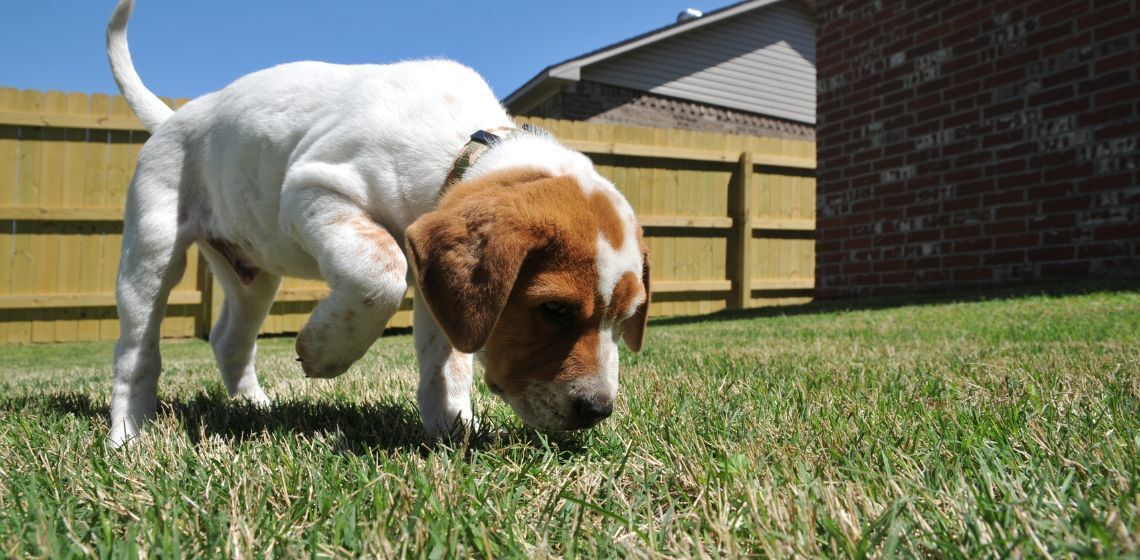Table of Contents
What Are Dog Hookworms?
These worms get their name because of their bodies’ bent, hook-like shape. Adult hookworms can grow up to 20 mm in length.
Hookworms in dogs primarily stay in the small intestines. They feed on blood and can cause life-threatening anemia, especially in young puppies.
Additional types of common gastrointestinal worms in dogs:
- Roundworms
- Tapeworms
- Whipworms
What Causes Hookworms in Dogs?
To understand how dogs become infected with hookworms, we must take a look at the hookworm life cycle.
Overview of hookworm life stages:
- Eggs: adult hookworms lay eggs in a dog’s small intestines which are released in feces into the environment
- First (L1) and second (L2) larval stages: these immature stages develop in the environment and cannot directly infect dogs
- Third (L3) larval stage (aka the infective stage)
- Fourth (L4) and immature fifth (L5) larval stages
- Adult hookworms: can survive between 4 to 24 months in a dog’s intestines
Dogs start shedding hookworm eggs between 10 to 21 days after becoming infected. Hookworm eggs hatch in about 1 to 3 days depending on environmental conditions like temperature and humidity. These eggs then develop into larvae capable of infecting dogs in as little as 2 to 9 days.
There are a few different ways a dog can become infected by hookworms.
- Routes of canine hookworm infection:
- Ingestion of infective third-stage larvae from the environment
- Ingestion of infected transport hosts
- Transmammary transmission from mother to puppies
- Skin penetration by infective larvae
Dogs can eat infective larvae from the environment. For example, they may ingest infective larvae when sniffing contaminated soil or grooming their paws after walking outside. These larvae can also penetrate a dog’s mouth and migrate throughout the body. But most ingested larvae mature in a dog’s digestive tract.
Although third-stage larvae are the infective stage of hookworms, dogs can also acquire hookworms by eating transport hosts infected with immature, dormant larvae. Examples of transport hosts include rodents, birds, or bugs. When hookworm larvae infect transport hosts, they become inactive and stop developing. When a dog eats an infected transport host, the larvae are released into the dog’s intestines and mature into adult worms.
Hookworms can periodically become dormant or inactive. This can occur after they migrate to other tissues in the body. Larvae can then become reactivated after a dog eliminates adult hookworms from the intestines or during pregnancy.
If a pregnant dog has a dormant hookworm infection, the larvae can reactivate and travel to her mammary glands. Nursing puppies can then become infected through their mother’s milk.
Another possible way hookworms can infect dogs is through the skin. Hookworms commonly penetrate the skin covering the stomach and feet that come into contact with a contaminated environment.
These intestinal parasites can migrate to other parts of a dog’s body including the lungs. Dogs tend to cough up these hookworms and swallow them, ultimately carrying them to the intestines.
Given the potential routes of infection and transmission, hookworm infections are more common in dogs in outdoor, crowded, or dirty environments. Hookworms are found around the world but are more prevalent in tropical and subtropical climates.
Hookworm Symptoms in Dogs
While dogs of any age are susceptible to hookworms, symptoms are more common and severe in puppies.
Because hookworms feed on blood, small puppies are at greater risk of anemia, iron deficiency, and unfortunately, death. Ancylostoma caninum in particular appears to be associated with more extreme anemia. Hookworms also excrete anticoagulants which interfere with a dog’s ability to clot blood appropriately.
Puppies with hookworm infections are usually sickly, lethargic, and weak. These pups often have pale gums and melena. Melena is digested blood, which appears as dark, tarry diarrhea.
Other signs of hookworms in puppies include dehydration, insufficient weight gain or growth, and poor hair coat. These symptoms are all a reflection of malnourishment due to compromised intestinal function.
Generally healthy, adult dogs with low numbers of hookworms may not show symptoms. However, it is important to identify these subclinical cases since they can still spread hookworms to other dogs.
Additionally, chronic hookworm infection can affect your dog’s overall health and well-being due to decreased appetite and weight loss.
In cases where hookworms migrate to the lungs, dogs can develop pneumonia and coughing.
Hookworms are also capable of penetrating the skin, particularly the spaces between a dog’s toes. When this occurs, dogs may develop dermatitis or inflammation of the skin.
In addition to external hookworm symptoms, hookworms also cause internal lesions and changes. For example, affected dogs will have bleeding ulcers with red and swollen intestines. As these parasites suck on their host’s blood, blood flow to the dog’s vital organs is inhibited.
Diagnosing Hookworms in Dogs
The Companion Animal Parasite Council (CAPC) states that all dogs should be tested for hookworms. Regular testing is important because hookworm infection is often subclinical, meaning symptoms are minimal to absent.
Puppies should be tested 2 to 4 times before they are 1 year of age and adults should be screened for infection 1 to 2 times each year. More frequent testing may be indicated depending on a dog’s lifestyle, risk, and history of previous hookworm infections.
The standard screening test for hookworm infection in dogs is centrifugal fecal flotation. After a stool sample is mixed with flotation solution via centrifuge, your veterinarian will examine the sample microscopically to look for hookworm eggs.
Although centrifugal fecal flotation is the most common way to test for canine hookworms, it will not identify all hookworm infections. For example, fecal flotation will not detect infections caused by worms incapable of laying eggs. This includes immature worms or single-sex infections (i.e. only female worms or only male worms present).
If your veterinarian suspects your dog has a hookworm infection but the centrifugal fecal flotation test is negative for eggs, she may recommend more specialized tests. Specifically, an antigen fecal test or a fecal PCR test to detect hookworm DNA may be indicated.
Situations when hookworm infection may not be detected by centrifugal fecal flotation:
- Very few worms and eggs
- Only female or only male worms (i.e. breeding and egg production are not possible)
- Immature worms incapable of breeding
Puppies with severe hookworm infections often die before hookworm eggs can be passed in their feces. Therefore, your veterinarian may recommend a specialized test in addition to centrifugal fecal flotation.
To optimize the chances of detecting all hookworm infections, the best diagnostic strategy is to combine centrifugal fecal flotation with an antigen fecal test. Combining these tests increases the chances of early diagnosis and thus, improves treatment success.
Hookworm Treatment in Dogs
Your veterinarian can explain in greater detail how to get rid of hookworms in dogs. But in general, your vet will prescribe an appropriate dewormer. The main hookworm medicine for dogs includes fenbendazole, milbemycin oxide, moxidectin, and pyrantel pamoate. These medications are only effective against adult hookworms and therefore, treatment must be repeated to address all life stages as they develop.
A growing problem is that canine hookworms are becoming resistant to routine deworming medications. This is why it is important to perform a fecal flotation 2 weeks after initial deworming to evaluate the efficacy of treatment. If the hookworm egg count is not decreasing sufficiently, your dog may have a resistant hookworm infection. Dogs with hookworm resistance may require a different medication or combination of drugs.
In severe cases of canine hookworm infection, treatment usually requires deworming medication (aka an anthelmintic) as well as supportive therapy. Supportive therapy typically consists of fluid therapy to keep patients hydrated as well as temperature and nutritional support. Dogs with severe anemia may also require blood transfusions.
How to Prevent Hookworm in Dogs
If a mother is infected with hookworms, her puppies can be reinfected multiple times while nursing or in a continuously contaminated environment. Unfortunately, hookworm infection often kills puppies before a definitive diagnosis can be made. To prevent potential hookworm infections from progressing to this point, all puppies and their mothers should be dewormed on a certain schedule.
All puppies and their mothers should be dewormed when the puppies are 2, 4, 6, and 8 weeks old. Puppies should be started on a monthly preventative once they are old enough according to the product’s label guidelines. If for some reason puppies are not dewormed until they are 6 weeks of age or older, the recommendation is to treat with an appropriate dewormer and then repeat this treatment in 2 weeks to address all life stages of the parasite.
There are a couple of different options for treating pregnant dogs but this regimen must be approved by your veterinarian since these treatments are considered “off-label” and may not be safe for every dog.
All dogs (once they are old enough) should be given a monthly preventative year-round. Many heartworm preventatives also work to prevent intestinal parasites like hookworms. There are many different products available and your vet can help you choose one that is safe and works best for your dog.
In addition to administering a monthly preventative, there are several practices all dog owners should do to help reduce environmental contamination and the spread of hookworms.
Practices to help prevent hookworms in dogs:
- Pick/clean up your dog’s feces immediately
- Keep your dog on a leash in open, outdoor public areas
- Wipe off your dog’s feet after walks
- Prevent your dog from eating transport hosts (i.e. via hunting or scavenging)
Because hookworms feed on blood, they can cause severe anemia and death, especially in young puppies. Hookworms are not only a concern for your dog, but for you and your family. This is because hookworms are zoonotic, meaning they can also infect humans.
Not all dogs with hookworms exhibit noticeable symptoms, especially otherwise healthy adult dogs. Symptoms are most common in young puppies or dogs infected with a high number of hookworms. Young puppies with hookworms are more prone to life-threatening anemia. These puppies are typically weak and dehydrated. Hookworm infection in dogs can cause pale gums, weight loss, decreased appetite, and dark tarry diarrhea. Dogs may also develop skin inflammation and coughing.
If treatment is effective, the hookworm egg count via fecal flotation should be reduced by 95% 2 weeks after the initial deworming. However, if your dog has a hookworm infection that is resistant to routine deworming medications, he may require multiple treatments over a longer period.
Hookworms are highly contagious and all dogs are at risk of becoming infected at any point in their lives. There are multiple possible routes of infection but hookworms can be spread directly from dog to dog through transmammary transmission; if a mother dog has hookworms, she can infect her entire litter of puppies through her milk. Since hookworm eggs are shed in a dog’s feces, dogs can easily become infected if they come into contact with an environment contaminated with canine feces.

Dr. Amanda Takiguchi received her Doctor of Veterinary Medicine degree at Colorado State University. After that, she completed additional training at Texas A&M through a small animal rotating internship. Prior to veterinary school, Dr. Takiguchi studied dance and business management at Columbia University in New York City. She primarily works with dogs and cats but also loves exotic species like rabbits. Her favorite animal that has worked with is the native Hawaiian owl. When she is not promoting animal welfare, Dr. Takiguchi still loves to dance, with training in multiple styles including hip hop, ballet, and tap.








